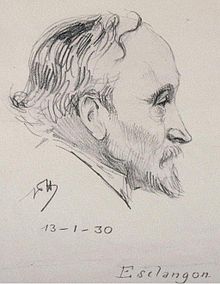Ernest Esclangon
Ernest Benjamin Esclangon (born March 17, 1876 in Mison near Sisteron , † January 28, 1954 in Eyrenville , Dordogne ) was a French astronomer, physicist and mathematician.
Esclangon studied from 1895 to 1898 at the École normal supérieure , then worked as an astronomer at the observatory in Bordeaux and received his doctorate in Paris in 1904 (on quasi-periodic functions). In 1918 he became director of the observatory in Strasbourg and in 1919 professor of astronomy at the University of Strasbourg . From 1929 he was director of the observatory in Paris and the Bureau International de l'Heure . He was also a member of the Bureau des Longitudes from 1932 . In 1944 he retired.
As a mathematician he was a pioneer in the study of quasi-periodic functions (independent of Piers Bohl ), which were later treated in detail by Harald Bohr as almost periodic functions . During the First World War, he dealt with ballistics and found a method of localizing the location of guns acoustically. In 1933 he organized a time announcement as a telephone service in Paris. As an astronomer, he improved the passage instruments .
In 1935 he received the Jules Janssen Prize , in 1929 he was elected to the Académie des sciences . The asteroid Esclangona is named after him, as is the lunar crater Esclangon and a street in Paris.
Web links
- Publications by E. Esclangon in the Astrophysics Data System
- Obituaries for E. Esclangon in the Astrophysics Data System
- John J. O'Connor, Edmund F. Robertson : Ernest Esclangon. In: MacTutor History of Mathematics archive .
Individual evidence
- ^ List of members since 1666: Letter E. Académie des sciences, accessed on November 11, 2019 (French).
- ↑ http://www.v1.paris.fr/CARTO/nomenclature/3361.nom.html ( Memento from August 12, 2007 in the Internet Archive )
| personal data | |
|---|---|
| SURNAME | Esclangon, Ernest |
| ALTERNATIVE NAMES | Esclangon, Ernest Benjamin (full name) |
| BRIEF DESCRIPTION | French astronomer, physicist and mathematician |
| DATE OF BIRTH | March 17, 1876 |
| PLACE OF BIRTH | Mison at Sisteron |
| DATE OF DEATH | January 28, 1954 |
| Place of death | Eyrenville , Dordogne department |
